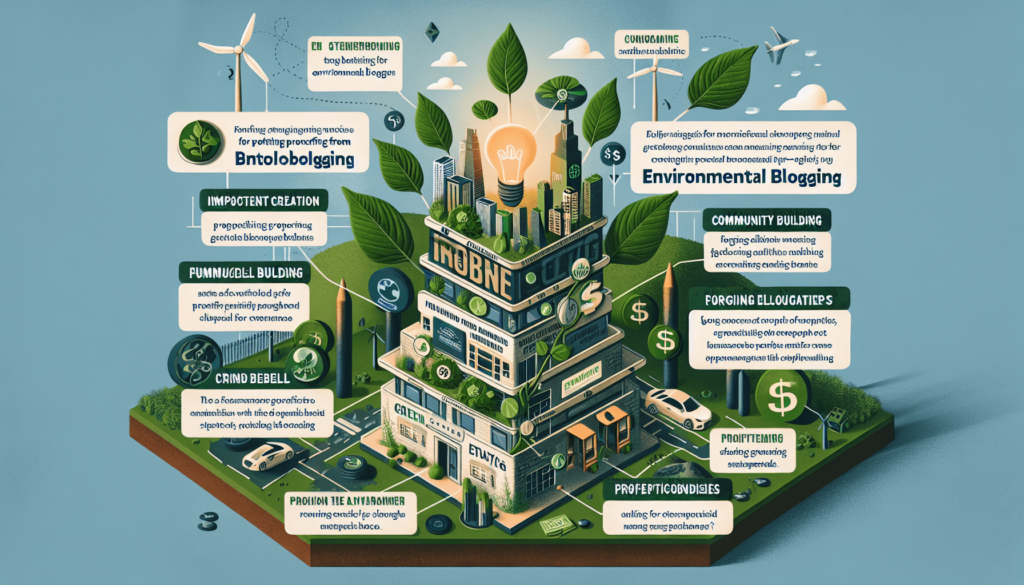In the ever-evolving landscape of the digital age, the potential for creative endeavors to also be lucrative is vast. Our focus today is on the world of environmental blogging, where passion for sustainability and the written word can come together to create not only a platform for educating and inspiring others, but also a means for generating income. In this article, we will explore the innovative strategies that exist for monetizing environmental blogs, uncovering unique approaches that go beyond traditional advertising and sponsorship opportunities. Get ready to discover the untapped possibilities that lie within the realm of environmental blogging and how to capitalize on them. BackersHub.com is where possibilities meet profitability, and we’re here to guide you through this exciting journey.
Unlock Earning Power: My $7 Mega Link Secret Revealed!
Affiliate Marketing
1. What is affiliate marketing?
Affiliate marketing is a popular strategy used by bloggers and content creators to earn income by promoting products or services offered by other companies. In this model, individuals or websites become affiliates and earn a commission for every sale or referral they generate through their unique affiliate links. It’s a win-win scenario as bloggers can monetize their content while companies can reach a wider audience and increase their sales.
2. How to get started with affiliate marketing?
To get started with affiliate marketing, the first step is to choose a niche that aligns with your environmental blog. Identify products or services that resonate with your audience and have a positive impact on the environment. Once you have chosen your niche, you can research and join affiliate programs offered by relevant companies. These programs provide you with unique affiliate links that you can incorporate into your content.
3. Finding suitable affiliate programs
Finding suitable affiliate programs for your environmental blog is crucial for success in affiliate marketing. Look for companies that share the same values and mission as your blog. Explore eco-friendly brands, sustainable products, or services that promote environmental conservation. Affiliate networks like ShareASale and CJ Affiliate can help you discover a wide range of affiliate programs to choose from. Additionally, reach out directly to companies you admire and inquire about their affiliate programs.
4. Creating engaging content for affiliate marketing
Creating engaging content is key to effectively promote affiliate products and maximize your earnings. A successful affiliate marketing strategy involves creating informative, honest, and valuable content that resonates with your readers. Write product reviews, comparison articles, or listicles that highlight the benefits and features of the products or services you are promoting. Incorporate your affiliate links naturally within the content and provide clear calls-to-action that encourage readers to explore or purchase the products.
Sponsored Content and Product Reviews
1. What is sponsored content?
Sponsored content involves collaborating with brands or companies to create content that promotes their products or services. Bloggers and content creators can receive compensation for featuring sponsored content on their platforms. Sponsored content can range from blog posts and videos to social media campaigns. It is essential to maintain transparency and disclose any sponsored content to your audience.
2. Finding brands interested in sponsored content
To find brands interested in sponsored content, start by conducting research on companies that align with your blog’s environmental focus. Reach out to them through email, social media, or their official websites. Many brands have dedicated influencer or sponsorship programs that you can apply to. Networking events, industry conferences, and online platforms like BackersHub.com can connect bloggers with brands looking for sponsored content opportunities.
3. Creating authentic and valuable sponsored content
When creating sponsored content, it is essential to maintain authenticity and provide value to your audience. Craft content that aligns with your blog’s mission while incorporating the brand’s messaging and offerings. It is crucial to be transparent and clearly disclose any sponsored content to maintain trust with your readers. Focus on creating engaging and informative content that educates and entertains your audience.
4. Conducting product reviews for income
Product reviews can be a lucrative source of income for environmental bloggers. Similar to sponsored content, companies can send you products to review and provide your honest feedback. Write detailed and unbiased reviews that highlight the product’s eco-friendly features, performance, and benefits. Be transparent and disclose any relationships or compensation involved in the review process. Including affiliate links alongside your reviews can further generate income when readers make purchases through your recommendations.

Life-Changing: How a Simple Link Brought Me Financial Freedom!
Online Advertising
1. Contextual advertising
Contextual advertising involves displaying targeted advertisements based on the content of your blog. Advertising networks like Google AdSense analyze your blog’s content and display relevant ads to your audience. These ads can be in the form of text, image banners, or video advertisements. Contextual advertising is an effective way to earn income, as you get paid for clicks or impressions on the ads displayed on your blog.
2. Display advertising
Display advertising refers to the placement of visual advertisements on your blog. Instead of relying on ad networks, you can directly collaborate with brands or companies and negotiate display ad placements. These visual ads can be in the form of static or animated banners, interactive elements, or sponsored content. Display advertising can provide a steady income stream, especially when partnering with brands that resonate with your audience.
3. Optimizing ad placement and formats
To maximize ad revenue from online advertising, it is crucial to optimize ad placement and formats on your blog. Experiment with different ad placements and monitor the performance of each placement. Strategic placement of ads within your content or sidebar can increase visibility and engagement. Additionally, consider the format of the ads. Native ads that seamlessly blend with your content tend to perform better than intrusive or disruptive ads.
4. Maximizing ad revenue through ad networks
Ad networks like Mediavine or AdThrive offer an opportunity to maximize ad revenue through a higher RPM (revenue per thousand impressions). These networks typically require blogs to meet certain traffic and quality criteria. By joining these networks, you can benefit from their industry expertise, advanced ad optimization, and access to premium advertisers. Partnering with ad networks can significantly increase your ad revenue and provide ongoing support to maximize your earnings.
Digital Products and Services
1. Creating and selling e-books and guides
Creating and selling digital products like e-books and guides is a great way to generate income from your environmental blog. Leverage your expertise and knowledge to create comprehensive resources that provide value to your audience. Topics can range from eco-friendly lifestyle guides to sustainability tips and techniques. Platforms like Amazon Kindle Direct Publishing or Gumroad can help you self-publish and distribute your digital products to a global audience.
2. Developing online courses or webinars
Online courses and webinars are in high demand, and they offer a lucrative income opportunity for environmental bloggers. Share your expertise in a structured manner through video lessons, worksheets, and quizzes. Develop courses or webinars that cover topics like sustainable living, renewable energy, or organic gardening. Platforms like Teachable or Thinkific provide user-friendly tools to create and monetize your courses. Alternatively, you can host live webinars and charge attendees for access to your knowledge and insights.
3. Offering consulting services or coaching sessions
Another way to monetize your environmental blog is by offering consulting services or coaching sessions. Position yourself as an expert in your niche and offer one-on-one or group consulting sessions. Provide personalized advice, guidance, and solutions to individuals or businesses looking to make a positive environmental impact. Advertise your services on your blog, social media platforms, or through industry networks. Ensure that your pricing is competitive and reflective of the value you provide to your clients.

Daily Payday From Your Couch? Try now for the cost of a cup of coffee!
Membership and Subscription Models
1. Creating premium content for members
Creating premium content exclusively for members of your blog can be a sustainable income stream. Offer additional value to your most dedicated readers by providing access to exclusive content, in-depth articles, video tutorials, or behind-the-scenes insights. This membership model can be implemented through platforms like Patreon or by setting up a members-only section on your website. Consistently deliver high-quality content to incentivize readers to become paying members.
2. Implementing paid subscriptions or memberships
Implementing paid subscriptions or memberships allows you to monetize your environmental blog by providing additional benefits to paying subscribers. Offer tiered subscription options with varying benefits such as ad-free browsing, early access to content, exclusive discounts, or personalized newsletters. Choose a subscription platform like MemberPress or WooCommerce Subscriptions to manage and process payments seamlessly.
3. Offering exclusive benefits and access to paying members
To attract paying members, offer exclusive benefits and access that incentivize them to join your membership program. Partner with relevant brands to offer exclusive discounts or freebies to your paying members. Organize virtual events, Q&A sessions, or private forums where members can interact with you and other eco-conscious individuals. Continuously engage with your paying members and ensure that they feel valued and appreciated for their support.
Crowdfunding
1. Exploring platforms for environmental projects
Crowdfunding is an innovative way to generate income for your environmental initiatives. Platforms like Kickstarter or Indiegogo allow you to present your project to a wide audience and raise funds for implementation. Create a compelling campaign that highlights the environmental impact of your project, your goals, and the rewards backers will receive. Leverage the power of storytelling, visuals, and videos to engage potential backers and motivate them to support your cause financially.
2. Developing compelling campaigns
Developing compelling crowdfunding campaigns requires careful planning and storytelling. Clearly communicate the purpose of your project and the positive impact it will have on the environment. Use visuals, videos, and testimonials to evoke emotions and engage with potential backers. Offer enticing rewards and incentives for different levels of contributions to entice backers to donate. Continuously update your campaign page with progress reports, upcoming milestones, and gratitude towards your supporters.
3. Offering attractive rewards and incentives
To attract backers to your crowdfunding campaign, offer attractive rewards and incentives that align with your project and resonate with your audience. Rewards can range from exclusive merchandise, personalized experiences, or credits and acknowledgments in your project. Make sure the rewards are relevant and valuable to your backers, and create a sense of exclusivity or limited availability to drive participation. Regularly communicate updates and ensure your backers feel appreciated for their support.
Shocking! This one link can pay you time and time again!
Brand Collaborations and Partnerships
1. Identifying potential brand collaborations
Identifying potential brand collaborations is essential for generating income and creating mutually beneficial partnerships. Research companies or brands that align with your environmental values and have a similar target audience. Look for brands that have sustainability initiatives, eco-friendly products, or a commitment to environmental conservation. Reach out to them directly with a well-crafted pitch highlighting the benefits of collaborating with your blog and the value you can provide to their brand.
2. Creating mutually beneficial partnerships
Creating mutually beneficial partnerships requires establishing a clear understanding of each party’s goals, values, and expectations. Discuss how your blog can endorse their products or services in a way that resonates with your audience. Offer promotional opportunities such as sponsored blog posts, social media features, or product placements. In return, negotiate compensation or benefits for your efforts, such as monetary compensation, free products, or increased exposure for your blog.
3. Negotiating sponsorship deals and collaborations
When negotiating sponsorship deals and collaborations, it’s important to consider the value you bring to the partnership. Highlight your blog’s reach, engagement, and the quality of your content. Clearly define the deliverables, timelines, and compensation expectations. Be open to negotiation while ensuring that the partnership aligns with your blog’s values and mission. Establish a mutually beneficial relationship that can lead to long-term collaborations and increased income opportunities.
Workshops and Events
1. Organizing environmental workshops or seminars
Organizing environmental workshops or seminars can be a source of both income and community engagement. Choose a topic relevant to your blog’s niche and expertise. Plan and promote the event through your blog, social media, and local networks. Offer educational sessions, hands-on activities, and expert panels to provide value to attendees. Charge a fee for participation or seek sponsorships from companies or organizations interested in reaching your audience.
2. Partnering with relevant organizations for events
Partnering with relevant organizations for events can expand your network, enhance your credibility, and generate income. Identify local environmental organizations, non-profits, or businesses that share similar goals and values. Collaborate on workshops, conferences, or panel discussions that bring together like-minded individuals and offer valuable insights. Seek financial support from sponsors and charge attendees for tickets to cover event expenses and generate income.
3. Generating income through ticket sales and sponsorships
To generate income from workshops and events, consider charging attendees for tickets. Determine a fair and competitive ticket price based on the value of the content and the expertise of the speakers. Offer early bird discounts, group rates, or premium packages to entice attendees to purchase tickets. Additionally, seek corporate sponsorships to cover event costs or provide in-kind support. Approach companies or organizations that align with your event’s theme and offer them sponsorship opportunities in exchange for financial contributions or resources.
Unlock Earning Power: My $7 Mega Link Secret Revealed!
Donations and Sponsorship
1. Exploring donation platforms or plugins
Exploring donation platforms or plugins can provide an avenue for your audience to contribute financially to your environmental causes. Platforms like PayPal Donations or GiveWP allow you to embed donation buttons or widgets on your blog. Invest time in crafting a compelling narrative that explains how the donations will be used to support your environmental initiatives. Regularly remind your audience of the option to donate and express gratitude for their support.
2. Engaging with the audience for support
Engaging with your audience is crucial in gaining their support and encouraging donations. Share updates on the progress and impact of your environmental initiatives. Use storytelling and visuals to evoke emotions and create a sense of urgency for support. Respond to comments and messages from your audience, fostering a sense of community and appreciation. Regularly communicate the importance of their support in driving positive change for the environment.
3. Seeking corporate sponsorships for environmental causes
To secure corporate sponsorships for your environmental causes, identify companies that have a vested interest in sustainability or environmental conservation. Research their corporate social responsibility initiatives and identify areas where your blog’s initiatives align with their values. Craft a compelling sponsorship proposal that outlines the benefits of collaboration and the positive impact their support can have on the environment. Offer different levels of sponsorship opportunities, such as event sponsorships, branded content, or long-term partnerships.
Life-Changing: How a Simple Link Brought Me Financial Freedom!

